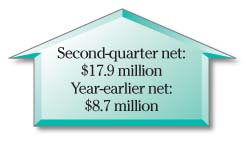Central Pacific cuts
earnings outlook
The bank expects lower income this year
because of increased loan prepayments
Central Pacific Financial Corp., bolstered by last year's acquisition of City Bank, doubled its net income in the second quarter but reduced its earnings-per-share guidance for the full year.
The state's fourth-largest bank benefited from strong deposit growth, an expanding net interest margin and increased efficiency to post record net income of $17.9 million, or 58 cents a share, compared with $8.7 million, or 53 cents a share, a year earlier when the banks were separate companies. The consensus estimate by five analysts surveyed by Thomson Financial was 59 cents.
 Central Pacific said yesterday it was reducing its 2005 earnings-per-share guidance to a range of $2.40 to $2.45 from $2.50 to $2.60 to reflect higher-than-expected second-quarter loan prepayments.
Central Pacific said yesterday it was reducing its 2005 earnings-per-share guidance to a range of $2.40 to $2.45 from $2.50 to $2.60 to reflect higher-than-expected second-quarter loan prepayments.
Prepayments in the bank's commercial real estate portfolio were $130 million higher than expected, Central Pacific said.
Brett Rabatin, an analyst with Memphis, Tenn.-based FTN Midwest Research, said he wasn't surprised the bank lowered its guidance.
"I think everybody expected that," he said. "That's a reflection of what a lot of banks in the West are experiencing. Commercial real estate loans are being refinanced at long-term fixed rates that are relatively lower and are unattractive to banks."
Excluding merger-related expenses, Central Pacific's operating earnings were $18.2 million, or 59 cents a share, compared with $8.8 million, or 54 cents a share, a year earlier.
 Merger-related expenses totaled $524,000 last quarter.
Merger-related expenses totaled $524,000 last quarter.
Central Pacific said its plan to buy residential mortgage broker Hawaii HomeLoans Inc. will complement the bank's residential development financing and provide new growth. Central Pacific said last month the deal would close within two months.
"We are optimistic about the second half of the year, as we expect to continue to grow our balance sheet, further improve our efficiency and expand our residential mortgage operations," Central Pacific Chief Executive Clint Arnoldus said.
Rabatin, who has a "neutral" rating on the stock, said the bank had a relatively strong quarter. But Joe Morford, a San Francisco-based analyst for RBC Capital Markets, wasn't as enthused.
"I thought it was a mixed quarter," he said. "They did meet the (estimated) number, but they also got about a penny of income from gains on loan sales. And loan growth was down because of the pay-downs.
"On the positive side, the cost savings are much better than expected, in part reflected from the synergies of the merger."
Central Pacific's assets and deposits jumped last quarter from a year earlier as a result of the merger.
Assets rose 96.8 percent to $4.9 billion while deposits gained 81.5 percent to $3.5 billion. Loans and leases doubled to $3.2 billion.
Net interest income, which reflects the difference of what the bank pays depositors and what it brings in from loans, more than doubled to $48.5 million from $22.6 million.
The net interest margin improved to 4.65 percent from 4.31 percent a year earlier.
The bank's efficiency ratio, which measures how much it costs Central Pacific to make a dollar of revenue, improved to 50.04 percent last quarter from 52.85 percent a year earlier.
Central Pacific said a borrower who filed bankruptcy in the second quarter boosted the bank's nonperforming assets to $16.1 million, or 0.33 percent of total assets, compared with $8.7 million, or 0.35 percent of assets, a year earlier.
Some $6.6 million of last quarter's nonperforming assets were attributable to the bankruptcy. Central Pacific said the loans are fully collateralized and it does not anticipate any losses.
Central Pacific's earnings last quarter included a $439.1 million net gain from investment securities.
www.cpbi.com
E-mail to Business Desk
[News] [Business] [Features] [Sports] [Editorial] [Do It Electric!]
[Classified Ads] [Search] [Subscribe] [Info] [Letter to Editor]
[Feedback]
